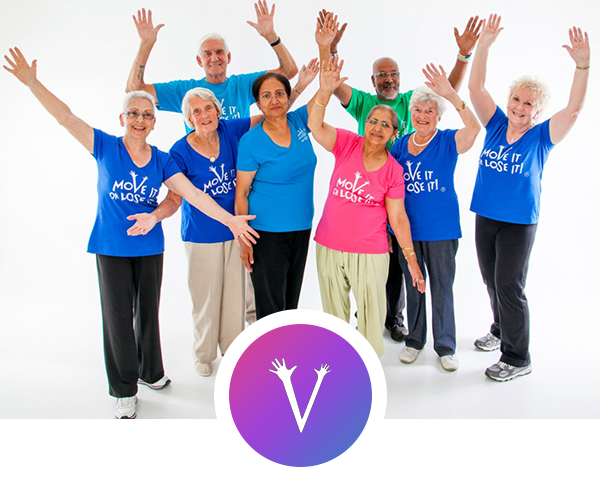Keeping our older demographic moving

We all understand the importance of moving more and sitting less when it comes to living a healthy and fulfilling life. As we age this becomes even more important as our lives tend to become more sedentary which then leads to ‘inflammageing’ and many long-term health conditions.
With the UK’s population increasingly becoming an ageing demographic there is considerable focus on getting older people more active. A recent report by Age UK 2016 highlighted that there are currently 11.4 million over 65s in the UK of which 75% do not partake in any physical activity or exercise – that’s a staggering 8.3 million older adults.
The consequences of physical inactivity as we age, are not just associated with movement problems and ill health, but also social issues of feeling isolated resulting in depression which find us entering into a downward spiral and consequent loss of independence. As we become more inactive we want to do less, the less we do the more isolated we become, the more isolated we become the more depressed we feel which prevents us from wanting to be active. In fact loneliness affects 10% of over 65s and can be as harmful as smoking 15 cigarettes a day*.
Unfortunately, the future looks somewhat bleak with Age UK research anticipating that by 2018, 7 million older adults will be unable to walk one flight of stairs without resting. Nobody wants this for their parents or grandparents as the consequences lead to a potentially higher risk of falls, dependence and need for care.
Professor Janet Lord, Director of the Centre for Healthy Ageing Research at University of Birmingham and advisor for the recent BBC One Programme ‘How to Stay Young’ says, “Exercise is the best medicine. We can reduce our risk of heart disease, some cancers, diabetes, obesity, arthritis and osteoporosis by up to 50% by simply getting people to move more and sit less.”
So how can we get older people, more active, more often? Julie Robinson, Founder of Move it or Lose it! (a specialist training provider for older adult exercise of which Professor Lord is an advisor), has motivated tens of thousands of people to get moving and have fun.
Following the ‘How to Stay Young’ documentary, the BBC chose four older adults for Julie to train. After just an eight-week training programme focusing on flexibility, aerobic exercise, balance and strength, the improvements were significant.
The 30 second Sit to Stand, a key marker of lower body strength and endurance which involves standing up and sitting down in a chair as many times as possible in 30s (hence replicating a squat movement pattern) was used pre and post the 8-week programme. So to was the Timed Up and Go, a universal test of functional mobility and falls risk which involves standing from a chair, walking 4m, turning around 180° and returning to sit in the chair.
Scores for the 30s Sit to Stand (STS) improved by an average of 7 (±3.4), and scores for the Timed Up and Go (TUG), improved by an average of 2s (±1.0s). As it takes a walking speed 1.2 m/s to safely cross a pedestrian crossing (Asher et al., 2012), that’s the difference between crossing the road safely or not, and being able to stand up from a chair independently and with confidence – two hugely significant activities of daily living (ADLs).
Move it or Lose it! has subsequently developed the FABS Training Programme. This includes Flexibility, Aerobic, Balance and Strength into every exercise class and can be adapted for participants who need to do chair-based or standing exercises. The aim of the class content is to increase strength and muscle density to reduce sarcopenia, improve balance to reduce the risk of falls, increase aerobic capacity to enable individuals to be more active and increase flexibility and mobility to aid everyday life.
The FABS classes are currently being used as part of a NHS study for COPD (Chronic Obstructive Pulmonary Disease) patients being delivered in GP surgeries based in the West Midlands. Patients will be monitored in aspects of biopsychosocial health with the aim of rolling out the sessions across the NHS. The results will also be used to form the basis of a scientific research study which aims to reduce the effects of illnesses and long-term health conditions linked to inactivity in older people – such as diabetes and heart disease.
Julie is now looking for instructors who share her passion and want to make a difference to the lives of older people by helping them to live healthier for longer. Move it or Lose it! offers a comprehensive training programme to develop specialist skills and motivational techniques developed by experts in healthy ageing enabling instructors to work safely and effectively with this demographic.
With job opportunities available in the West Midlands for the right instructors and a need for Master Trainers nationwide, now is the time to join the Move it or Lose it! team helping the nations’ older adults to get active, whilst earning a healthy income for delivering a rewarding, fun and engaging class. As an existing fitness instructor you can benefit from the Fast Track entry costing £295 or £195 with EMD bursary (normal cost of the full course is £480).
If you want to get involved and help people to live longer, happier, healthier lives, simply request an information pack fabs@moveitorloseit.co.uk or call 0800 612 7785 www.moveitorloseit.co.uk/fabs
*Age UK Loneliness Evidence Review